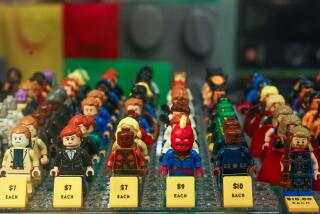Little Going Over Big
- Share via
LAGUNA NIGUEL — Leon Halperin looked stricken as he cut through a crowd of financiers to tell his client the bad news.
“The Edsel is missing,” he whispered to John Rempel, chief financial officer of Creative Master International Inc., a maker of model cars and other collectibles.
The pocket-sized, red-and-white station wagon with real wood paneling, leopard upholstery, seat belts and retractable antenna had obviously struck a chord at the 11th Annual Growth Stock Conference here last week. Halperin said he brought the die-cast model to an executive lunch and it disappeared.
Rempel was busy promoting the news that Hong Kong-based Creative’s quarterly earnings had risen fourfold when he received word of the missing $130 collectible miniature. He began racking his brain to figure out who swiped the car.
Earlier in the day, Carl Tong, Creative’s chief executive, had flashed the 1957 Edsel before a standing-room-only crowd of investors and analysts.
Creative, formed in 1986, makes die-cast metal replicas of trucks, cars, trains and objects including tiny outboard motors that go “vroom.” Its customers include Mattel Inc., for which it makes special edition Matchbox cars, Danbury Mint, Hallmark Cards Inc., Corgi and Lionel. Creative also makes special edition NASCAR racing vehicles.
Creative has benefited from a surge in collecting among baby boomers. So have its competitors, which include Hong Kong-based collectibles maker Zindart Ltd. the largest producer of Hallmark keepsake ornaments; Glen Ellyn, Ill.-based Racing Champions Corp., which specializes in NASCAR and other racing car replicas; and Phoenix-based Action Performance Companies Inc., which designs, markets and distributes licensed motorsports merchandise.
All of these companies reported significant sales increases in recent quarters.
Industry estimates have pegged growth of the U.S. collectibles market since 1993 at about 11% annually to about $10 billion in 1997, he said.
In the same period, the die-cast metal segment has grown at about 29% a year to an estimated $753 million.
“Collectibles is a growing market,” said E. Breck Wheeler, an analyst with J.C. Bradford. The trend “definitely is benefiting from baby boomers who are tending to have disposable income and a desire to collect things.”
The collectibles market is a good investment because it is more stable than the toy market, analysts said.
“It has not been as hit driven,” Wheeler said. “When I think of the toy business I think about things like Furby. Next year Furby will be a nonevent, in my opinion. This is more about evergreen products. Die-cast ’67 Chevys . . . were not just hot in 1967.”
Even Mattel is getting into the act. Five years ago it began making costlier and more highly detailed Matchbox and Hotwheels cars especially for adults.
While children’s Matchbox cars usually sell for around $1, adult Matchbox cars, made for display rather than play, can retail for anywhere from $10 apiece up to $200.
To meet increasing demand, Creative Master said it has more than doubled its production capacity since 1996. Tong said the company also has begun to focus on certain product lines that have increased in popularity.
“On our road show we keep losing the cars,” Tong laughed. The hottest models are the historical models such as the missing red-and-white 1957 Edsel.
Ironically, the Edsel, made by Ford from 1957 through 1962, was not popular in its day. But it seems very popular among baby boomers nostalgic about idyllic suburban jaunts in wood-paneled station wagons, Tong said.
Suddenly, Rempel, 43, realized that he had stashed the Edsel in his own bag--for safekeeping.
More to Read
Inside the business of entertainment
The Wide Shot brings you news, analysis and insights on everything from streaming wars to production — and what it all means for the future.
You may occasionally receive promotional content from the Los Angeles Times.










